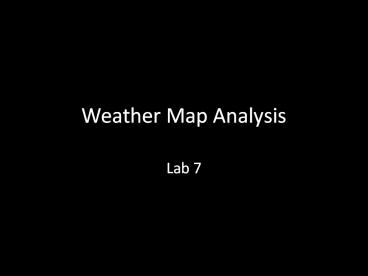Weather Map Analysis PowerPoint PPT Presentation
Title: Weather Map Analysis
1
Weather Map Analysis
- Lab 7
2
Can include
- Frontal lines
- Barometric pressure
- Isolines
- Temperature
- Frontal zones
- Frontal air
3
- This is a surface weather chart. A weather map
describing the state of the atmosphere over a
large area at a given moment. - Synoptic Map map that shows weather conditions
for a specific time.
4
Weather Map AnalysisSimplified Surface Station
Model
- Data are always plotted in the same position
around the station symbol for consistent reading.
5
(No Transcript)
6
Barometric Pressure
- NORMAL AIR PRESSURE 950 1050 mb
- insert decimal point over 1 number from the
right to the left - replace the missing beginning number with a 9 or
10 - The barometric pressure has to fall within the
normal range (for our purposes) - EXAMPLE 130 1013.0 mb
7
Wind Direction
- Measured by where wind is coming FROM
- Will also determine the temperatures and moisture
content of the air mass - Pressure Gradient Force
8
Isolines
- Isolines (lines of constant value) generally used
to show spatial patterns of specific variables - Isotherms temperature
- Isodrosotherms dew point
- Typically drawn at 5 intervals
- Isobars barometric pressure
- Typically drawn at 4-mb intervals
9
- Streamlines used to show wind flow patterns
- Drawn parallel to wind barbs
- Begin at an upwind location
- End with an arrow where wind shifts abruptly
- Tips
- Look for corridors
- Draw streamlines from the tail to/towards the
head.
10
Air Masses
- large body of air with relatively uniform
temperature moisture characteristics - Form over large land or water surfaces
- Take on the temperature moisture
characteristics of the surfaces over which they
formed.
- Classification depends on
- Latitude determines temperature characteristic
(upper-case letter_ - Nature of the surface determines the moisture
characteristic (lower-case letter) - They are identified by two-letter codes
Ex cP
11
Types of Air Masses
mE maritime equatorial cT continental tropical
mT maritime tropical cP continental polar
mP maritime polar cA continental arctic
Is there a type of air mass missing from this
list?
12
(No Transcript)
13
Fronts
- boundary between two unlike air masses
- Identified by
- Sharp temperature gradient
- Sharp moisture gradient
- Sharp change in wind direction
- (in a clockwise direction)
14
Types of Fronts
- 1. Cold cold air advances on warm air
- Known to move more quickly
- Vertical cloud formation
- 2. Warm warm air advances on cold air
- Clouds form ahead of the front
3. Stationary neither air mass advances air
flow parallel to the boundary
- Occluded cold front overtakes warm front
15
Winds from the North COLD Winds from the South
WARM Winds from the East COOL
Cold front triangles extend into the warm
air Warm front semicircles extend into the cold
air.
16
- High pressure systems are characteristic of clear
skies - Low Pressure systems are characteristic of
precipitation and clouds
17
(No Transcript)
18
(No Transcript)
19
- Pressure changes with temperature
- Air flows from areas of higher pressure to areas
of lower pressure - source for most winds is solar radiation
(unequal heating of Earths surface) - High Pressure high barometric pressure. Air is
dense - Low Pressure low barometric pressure. Air is
light.
Cold (dense) HIGH PRESSURE
Warm (less dense) LOW PRESSURE
20
Coriollis Effect
- http//en.wikipedia.org/wiki/Coriolis_effect
21
(No Transcript)

